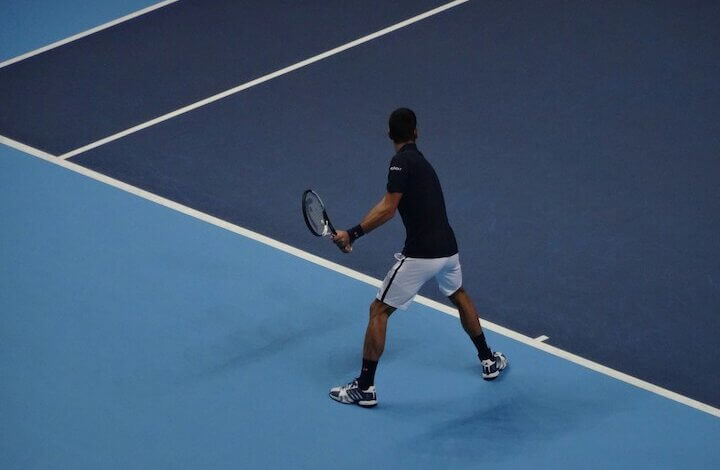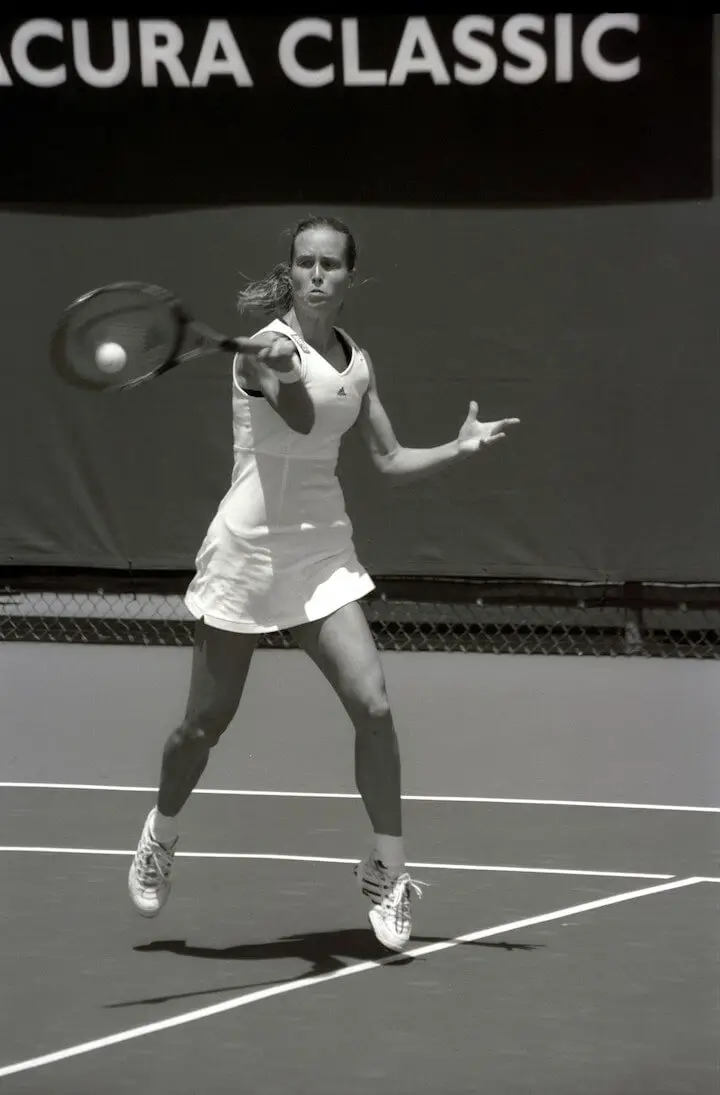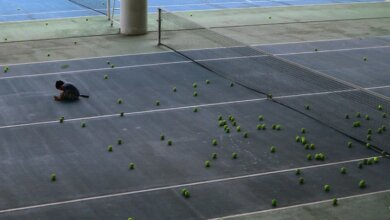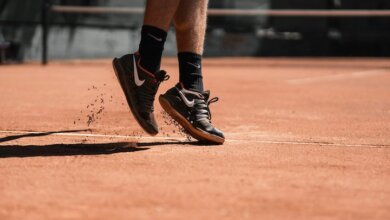
We're an affiliate
We hope you love the products we recommend! Just so you know, we may collect a share of sales or other compensation from the links on this page. Thank you if you use our links, we really appreciate it!
So there I was, stuck mid-rally, heart thumping, the ball coming fast toward my right side. My brain froze for a second. Should I stay open or step in? That moment—right there—is what this entire post is about. The open stance vs closed stance forehand.
If you’ve been wondering about the open stance vs closed stance forehand, you’re not alone. It’s one of those things that seems small but feels huge when you’re actually playing. Maybe you’ve heard someone throw those terms around, or maybe your coach told you to “step into the ball” and it just didn’t feel right.
Don’t worry, you’re in the right place.
I’m not here to make things complicated. I’m here to help you understand what each stance is, how they feel, when they actually make sense, and how to decide which one fits you.
And no—you don’t need to be a pro to figure this out.
Table of Contents
Key Takeaways
- The forehand stance is your body’s setup for every shot.
- Open stance is better for fast, wide, or defensive situations.
- Closed stance is great when you have time to step in and drive forward.
- The best players use both stances depending on the moment.
- Practice both stances calmly and feel what suits you best.
What Is a Forehand Stance?
Let’s strip it down.
A forehand stance is just the way you set up your feet and body before you hit a forehand shot. That’s it.
It’s your body’s base. It’s how you balance yourself, generate power, and move into (or out of) the next shot. Think of it like this: if the forehand is your swing, your stance is your foundation.
What Is an Open Stance Forehand?
Alright, picture this.
You‘re on the baseline, the ball is coming fast, and instead of stepping into it, you turn your hips slightly and keep your feet more parallel to the net. Your front foot doesn’t cross over. Your back leg bears most of the weight.
That’s an open stance forehand.
It’s called “open” because your hips and chest stay a bit more open toward the court, even as you rotate into the shot. You’re not closing off your body like in traditional footwork.
You’ll usually see this stance when:
- You’re pulled wide to your forehand side
- The ball is coming fast and you don’t have time to step in
- You’re looking to recover quickly for the next shot
And when you hit it right? It feels like you’ve loaded up a spring and released it in one clean snap.
What Is a Closed Stance Forehand?
Now let’s look at the other side of the coin.
The closed stance forehand looks more like what you’d see in older tennis footage. You step across your body with your front foot. Your back foot stays behind, and your shoulders turn away from the court. You’re closing your body off from the net before you unwind into the shot.
It feels more deliberate. More controlled. Like you’re stepping into the ball with purpose.
You’ll often use it when:
- You have time to set up
- The ball is slow or high
- You’re looking to drive through the court with a flatter shot
There’s something satisfying about stepping in, rotating fully, and finishing your swing smoothly across your body.
Also Read: 10 Best Tennis Shoes For Beginners
Open Stance: Why You’d Use It
Let me guess. You’ve found yourself scrambling left and right, barely keeping up, and someone shouts, “Hit it open stance!” It sounds vague at first. But when you do it, it clicks.
Here’s when you’ll want to use it:
- You’re under pressure
If you’re being pushed wide or the ball is coming too fast, the open stance lets you stay grounded without losing time stepping in. - You want quick recovery
Since your weight stays centered or slightly back, you can push off faster and get ready for the next shot. - You play mostly from the baseline
A lot of modern baseline players use this stance 80% of the time. It lets you hit with power and spin without overcommitting. - You like using your legs for power
That coiled feeling on your back leg? That’s where the explosion comes from. You load, then fire.
Open stance forehands are the bread and butter of fast-paced, open-court tennis. They let you stay fluid, react quickly, and recover fast.
Closed Stance: Why You’d Use It
Alright. Now let’s say the ball is floating in a little slower. You’ve got time. You feel balanced. That’s when a closed stance can feel like a dream.
Here’s why you might choose it:
- You’ve got time to step in
When you can position your body fully, the closed stance helps you transfer weight forward with precision. - You want linear power
That step across lets you drive through the shot like an arrow. Your momentum moves through the ball. - You feel more stable stepping in
Some players just feel more solid when stepping across. That’s totally okay. Comfort matters. - You’re attacking a short ball
If you’re moving into the court, the closed stance naturally helps you step into the shot and finish forward.
It’s slower to recover from, but it gives you full-body involvement—feet to shoulders. When it works, it’s smooth, strong, and satisfying.
Open Stance vs Closed Stance Forehand: The Feel and Flow
Now we’re getting into the part that most people skip.
It’s not just about technique. It’s about feel.
- The open stance feels more reactive. Like you’re using momentum and energy from the ground up. It’s elastic and explosive.
- The closed stance feels more composed. Like you’re taking your time and pushing the ball through with full control.
But here’s the key—neither one is better unless it fits your rhythm. Some people feel free with the open stance. Others feel stable with the closed one.
You’ve got to move, try, mess up, and listen to your body.
My Experience (And What Might Help You)
I used to force myself to use a closed stance because that’s what my coach told me. “Step in!” they’d say. And I tried. But every time I rushed, I felt stiff and off-balance.
Then one day, I just stayed open. I hit through the ball from where I stood, used my legs to push, and it clicked.
I didn’t care that it wasn’t textbook. It worked.
So here’s what I’d say to you: try both. Not in a tense match. Just you, a ball, and maybe a wall or a friend. Feel the difference. See what your body naturally prefers.
This isn’t about being perfect. It’s about being in sync with yourself.

How to Practice Both Without Overthinking
Keep it easy. Keep it light. Try these:
- Drop-feed yourself some balls
Just bounce and hit. Open stance, then closed stance. Alternate. Focus on how your legs and hips feel. - Shadow swings
No ball needed. Just pretend to hit forehands using both stances. Let your body learn the motion. - Slow rally with a friend
Call it out: “This one open, next one closed.” No pressure. Just get used to switching between the two.
And don’t aim for perfect form. Aim for balance and connection.
Check Out: 10 Best Tennis Shoes For Clay Court
Which Stance Is Better?
Here’s the part where people usually expect a verdict.
But let me be honest—there’s no universal “best.”
It’s not about choosing one and ditching the other. It’s about understanding when to use which, and why.
- If the ball is fast, wide, or you’re pinned back — use open stance.
- If the ball is slower, shorter, or you’ve got time — use closed stance.
Mixing them gives you freedom. Locking into one limits you.
So, next time you’re on the court, don’t ask, “Which is better?” Ask, “Which one fits this moment?”
Conclusion
So now you know. This whole open stance vs closed stance forehand debate? It’s not a fight. It’s a dance.
The stance you use changes how the shot feels. It changes how you recover. It changes how confident you are on the court.
You don’t need to pick one. You need to feel both.
Try them slowly. Don’t force anything. Your body knows more than you think. When it feels right, it is right.
Let it flow, let it be easy, and let it be yours.
Frequently Asked Questions
Can I use both stances during a match?
Yes, absolutely. In fact, you should. Every rally is different. Your feet will naturally shift based on where the ball lands and how much time you have.
Is open stance harder for beginners?
At first, yes. It feels awkward to hit without stepping in. But once you get used to loading your back leg and rotating your hips, it becomes second nature.
Why does my coach keep telling me to step into the ball?
Coaches often teach closed stance first because it builds strong fundamentals. But if it doesn’t feel right all the time, it’s okay to explore the open stance too.
How do I stop falling off balance in open stance?
Focus on loading your back leg and keeping your upper body steady through the swing. Don’t lean or reach—stay grounded.




